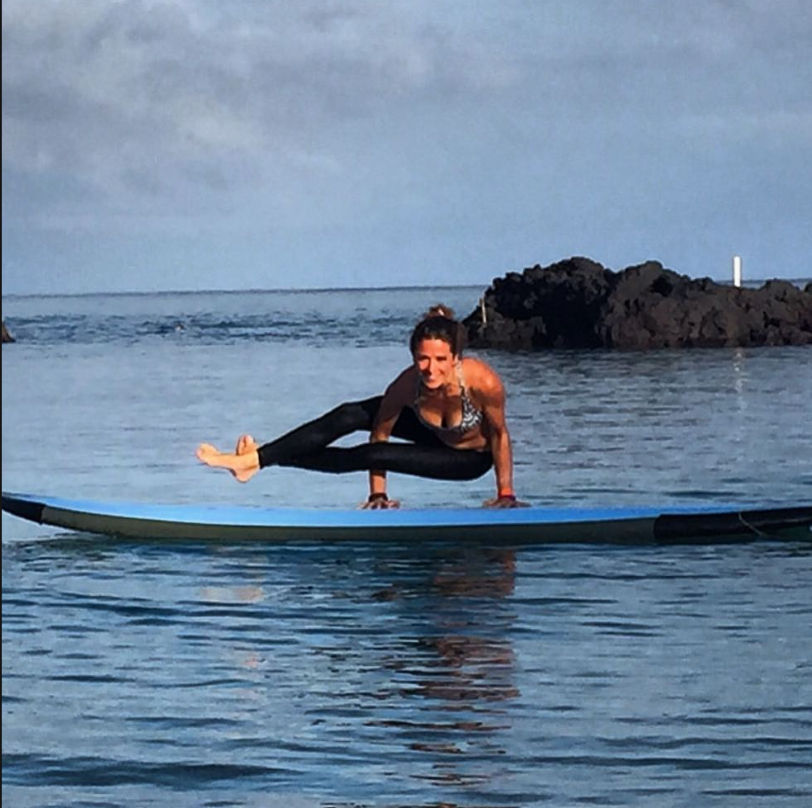
Discovering My Flow: Why Inversions and Arm Balances Feel Easier Than Standing Balances in Yoga
- chloedeedudley
- Apr 3
- 6 min read
As a former Division 1 athlete, I’ve always had a deep connection with my body. My early years were dedicated to pushing my limits, setting new goals, and competing at the highest levels of college athletics. However, that journey took a significant turn when I underwent an ACL tear my junior year and complete ankle reconstruction following my collegiate career. The experience reshaped not just my physical abilities, but also my approach to movement and balance, especially in the realm of yoga.
When I first stepped onto the mat, I quickly discovered that standing poses were a new kind of challenge. In my athletic days, my balance felt second nature; I could sprint, jump, and pivot with ease. Yet, here I was, struggling to find stability in simple standing postures. I realized that my body had changed; I was navigating the world with a reconstructed ankle that required constant attention and care. The old muscular habits I relied on were no longer as reliable, and I had to relearn how to find my center with a new set of constraints.

The frustration was palpable. I longed for the fluidity I once experienced while running the field, yet here I was, wobbling in Trikonasana (Triangle Pose) and feeling conspicuously unsteady in Vrksasana (Tree Pose). It was a humbling experience, coming to terms with my new reality and recognizing the grace I had taken for granted.
But as I grappled with standing balances, I found solace and surprising ease in arm balances and inversions. Poses like Bakasana (Crow Pose) and Adho Mukha Vrksasana (Handstand) felt more intuitive; they allowed me to leverage my upper body strength and find balance through the core. It struck me that these poses, which many see as advanced, actually provided me with the stability I craved but couldn’t find in my standing postures.
The contrasting experiences led me to reflect on why this was happening. Arm balances and inversions require a different kind of focus. They engage the core and upper body, shifting the weight and perspective compared to anchoring oneself on the ground in standing poses. In these moments of being upside down, I found freedom; I could detach from the struggle of the lower body and lean into the strength I had cultivated as an athlete.
Embracing this new lightness, I began to find joy in my practice, especially when I would nail a challenging arm balance. The adrenaline and excitement were reminiscent of the competitive nature I thrived on during my athletic career, and they provided a sense of fulfillment that I was unintentionally denying myself in standing poses.
While I continue to work on my standing balances, I’ve learned that my journey is unique and that I can celebrate the progress I’ve made. Instead of viewing my challenges as setbacks, I now see them as opportunities to navigate my body’s new language. Yoga has taught me that balance is not just about the physical act of standing still; it can also be found in how I approach my practice, embracing both my strengths and my limitations.
As a dedicated yogi, I have often found myself in the presence of peers marveling at the grace and stability of standing balances. Poses like Tree, Warrior III, and Half Moon seem to elicit a sense of awe, depicted as the ultimate tests of focus and strength within the yoga community. Yet, when I unfurl my mat and step into my practice, I discover something quite different: Inversions and arm balances feel refreshingly easier for me.
Understanding the Challenge of Standing Balances
While standing balances demand a strong foundation – both physically and mentally – I've come to realize that the precise alignment, stability, and focused concentration required can sometimes feel overwhelming. Standing on one leg or maintaining an elongated position might seem simple, but they bring a unique set of challenges. There's a relentless pressure to stay grounded, and for someone like me, the fear of wobbling can lead to anxiety, disrupting the flow of my practice.
Embracing the Freedom of Inversions
Conversely, when I flip my world upside down with inversions like Downward Dog, Headstand, and Handstand, there’s an immediate sense of liberation that washes over me. Being inverted seems to break the barriers of my expectations. I find myself tapping into an unconventional strength that goes beyond mere muscle; it's about flipping my perspective, both physically and mentally.
The element of gravity works differently when you’re upside down. Rather than fighting to stay balanced on one leg, I have the support of both arms and legs anchoring me in place. The focus shifts from maintaining an upright stature to discovering how to engage my core and balance my weight against gravity. This thrilling dance with balance brings me a joy that I often find lacking in standing poses.
The Art of Arm Balances
Arm balances resonate with me in a similar way. Poses like Crow (Bakasana), Side Plank (Vasisthasana), and Flying Pigeon (Eka Pada Galavasana) engage both strength and coordination but allow me to tap into a sense of playfulness. As I lift my body off the ground, I feel a rush of empowerment. The act of defying gravity fuels my confidence and encourages me to explore new levels of strength and awareness.
The connection between mind and body becomes incredibly pronounced in arm balances. When I’m balancing on my arms, there’s no space for distractions – every ounce of my focus must converge on the present moment. This intensity fosters a deep sense of mindfulness, which is sometimes harder to achieve while standing still.
Finding Balance Within
So, what has led me to this preference? I believe it boils down to personal anatomy, body awareness, and perhaps even mindset. Some practitioners may naturally have a stronger sense of balance or stability in one type of pose over another. For me, inversions and arm balances cater to my personal strengths, allowing me to thrive in a space where I truly feel my practice is elevating.
This doesn’t mean I avoid standing balances altogether; rather, I've learned to approach them with curiosity rather than expectation. Each standing balance becomes an exercise in patience, a gentle reminder that we each have different paths within our yoga journey.

While inversions and arm balances may seem counterintuitive, here are a few reasons why flipping your perspective might just lighten your practice:
1️⃣ Center of Gravity: In inversions, your center of gravity shifts, allowing you to engage your core more effectively. This can create a sense of stability that’s sometimes harder to find in standing postures.
2️⃣ Enhanced Focus: Being upside down naturally captures our attention. It encourages us to be fully present and connected with our breath, helping us cultivate concentration and mindfulness.
3️⃣ Strength Building: Inversions and arm balances challenge different muscle groups and help build overall strength. You'll find new power in your core, shoulders, and arms that translates to improved control across your entire practice.
4️⃣ Freedom & Release: Letting go of the ground can be liberating! Breaking the habitual patterns of standing balance allows for freedom in movement and exploration—embrace it!
5️⃣ Confidence Boost: Conquering an inversion or arm balance can provide a huge confidence boost, reinforcing that balance is not just physical— it’s about trust in your body and mind.
So the next time you're on your mat, consider flipping things around! Embrace the challenge of inversions and arm balances and see how it transforms your practice. Remember, yoga is all about exploration and finding what works for you!
Embracing Our Unique Journeys
In yoga, there’s incredible beauty in recognizing our individual strengths and weaknesses. It's essential to honor our unique paths instead of comparing ourselves to others. Whether you feel more at home in inversions, arm balances, or standing positions, every moment on the mat is an opportunity to grow, learn, and connect with yourself.
In the end, my experiences remind me that balance is a journey. It’s about learning to adapt, embracing where our bodies are, and allowing ourselves the grace to grow in unexpected ways. Whether it’s challenging standing poses or exhilarating inversions, each moment on the mat is an opportunity to connect with ourselves and discover how far we can push our boundaries. And while I may find arm balances easier right now, I know that with patience and practice, I’ll continue to find my footing in every pose—both on and off the mat.
So, to all the yogis out there struggling with balance, remember that your practice is your own. Celebrate the moments where you find strength, even if they look different from what you might expect. The beauty of yoga lies in its diversity, and every path is worthy of exploration.
If you're finding inversions and arm balances more suited to your practice, embrace it. Celebrate the freedom, the exploration, and the joy of movement. Remember, yoga is not about perfection—it’s about discovering what feels right for you in every pose. As we continue to unroll our mats and deepen our journeys, let’s support one another in honoring our distinct balances while finding our own flow.
Happy practicing friends! 🧘♀️✨



Comments